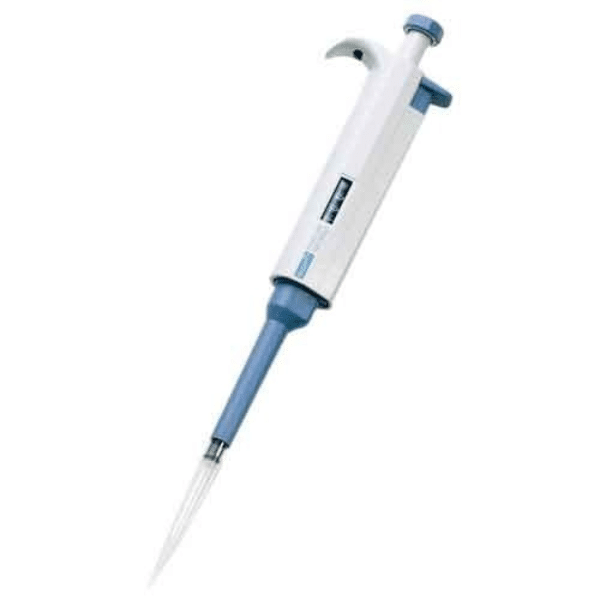The laboratory tool used for aspirating and distributing tiny quantities of liquid is called a micropipette. It can be as small as 0.2 microliters. These are employed in molecular, forensic, pharmacological, and diagnostic laboratories. It comes in a variety of variants depending on the working mechanics, capacity (P20-P10,000), channels (single and multi), and principle (air and positive displacement) (manual and automatic).
The Single Channel Adjustable Volume Autoclavable Micropipettes allow for simple cleaning, lower the danger of contamination, and are fully autoclavable. It is possible to perform a steam autoclave for 20 minutes at 121°C and one pressure. Before using the pipette, it must be cooled down and given 12 hours to dry after autoclaving. After each autoclaving, it is advised to assess the pipette's performance. After every tenth autoclaving, the pipette piston should be greased and sealed to ensure improved performance.
Features
- Type NO. is The M and P series.
- Volume Interval ranges between 0.1-2.5UL,0.5-10UL,10-100UL,100-1000UL... 2-10m
- Feature: Fully or partially autoclavable
- Type: Fixed Volume and Variable Volume
- Accessories: piping tips, lid
- Transportation Package: Separate boxes and export cartons
Specification
- Eight channels, 12 channels, and a single channel
Description
- Lightweight and ergonomic construction
- Volume setting is easily viewed on the Digital display.
- A broad measuring range, from 0.1 to 10,000 ul
- It might be completely autoclavable with new material.
- High resistance to corrosion in ceramic pistons
- PTFE sealing ring, more user-friendly
Working principle
Micropipette with Air Displacement: The air displacement principle underlies this kind of micropipette operation. It consists of a piston that aspirates and dispenses liquid samples in response to the air pocket rising and falling. The pipette's interior workings are not in direct touch with the sample or liquid. Instead, the liquid is drawn and released from the pipette using a disposable micropipette tip. Air displacement caused by pistons powers micropipettes.
When the piston is depressed downward, the air is forced out of the micropipette's sleeve, and as a result, the liquid at the pipette's tip is also removed. A vacuum is formed where the piston vacates as it moves upward. As a result, the liquid is pushed up into the tip, replacing the air from the tip, rising to fill the space.
Major Parts
- Plastic shaft: A plastic shaft is a tube-like structure filled with air in an air displacement micropipette. A small amount of air from the shaft is released as the piston is pressed, aiding liquid aspiration. In contrast, when the piston is released, the liquid is helped to flow, and the shaft is once more filled with air.
- The tip ejector button's arm is known as the ejector's arm. After pressing the ejector button, pressure is applied to the pipette cone.
- The pipette tip is linked to the tip cone at this location.
- Tip for the pipette: It is a piece of equipment made of virgin polypropylene or plastic that has been moulded into it and is in touch with the liquid.
- Plunger: The micropipette's highest component is the plunger. Plungers can be depressed to aid in aspirating and dispensing the required volume of liquids. There are two stops: the first is for desire, and the second is for dispensation.
- Tip ejector button: This button, located next to the plunger, enables you to remove or eject pipette tips without using your hands.
- The plunger has a knob attached to it that can alter the volume. It can be turned to set the desired volume in the micropipette with a changeable volume. A micropipette with a set volume cannot be rotated or turned.
- The digital volume display window shows the maximum volume the micropipette can withdraw.
What to avoid when using this product?
- Use a pipette with a tip connected at all times.
- Avoid exceeding a pipette's volume restrictions.
- Avoid cramming the pipette's tip into the device.
Maximizing on:
- Choosing the loudness
- Place the tip.
- At the initial halt, press and hold the plunger.
- Insert the tip into the fluid.
- Releasing the plunger gradually.
- Take a little pause before moving to the point.
- Place the tip into the delivery container.
- Squeeze the plunger until it stops.
- Wait two seconds.
- Take away the tip
- Let the plunger out.
- Throw the tip into the trash can.
Summary
Erroneous results and even pipette damage usually occur when product volume limit is exceeded. To save time, it is not worth stretching the micropipette's capabilities. Change to the appropriate pipette so you can work with the desired volumes. According to lab professionals who have pressed the tip into the pipette, tha tip must be fastened more firmly. That is the signal. Do not keep jamming the pipette tip if you do this repeatedly since it will break the shaft and cost you money to repair it.
